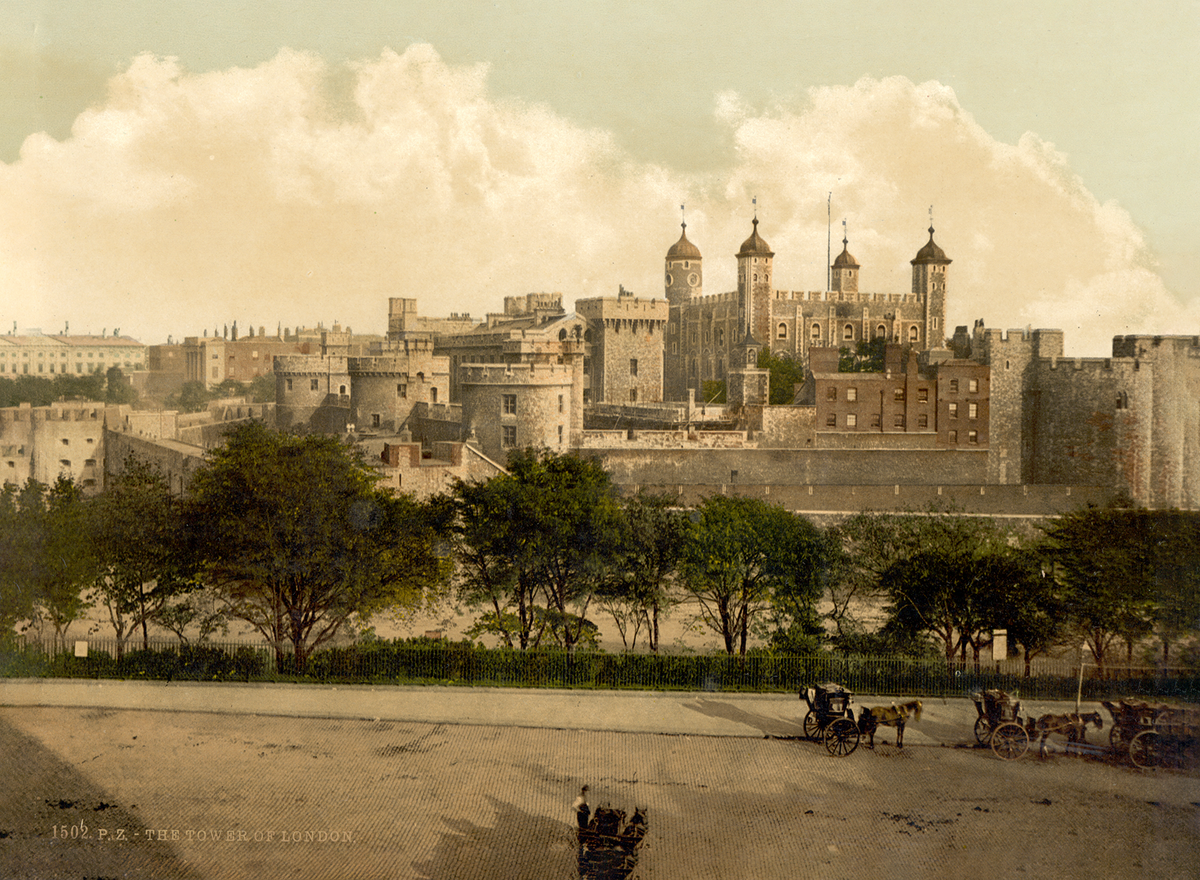The Stones Cry Out
The Tower’s walls were thick—but not thicker than truth. Through pain, martyrs carved their witness in stone. No bitterness, only faith: “Be faithful unto death, and I will give you the crown of life.” May we too leave a mark the world cannot erase.

Greetings!
On the morning of our last day in London, my phone buzzed. It was a message from Caleb, who had been with us on the trip:
“Good morning! I wanted to let y’all know that I scheduled a visit to the Tower of London this morning at 11 o’clock.”
My school-age study of history had made me well acquainted with the Tower of London and its many anguished occupants during the Reformation— Thomas Cranmer, Lady Jane Grey, Catherine of Aragon, Anne Boleyn, and countless others who had met their fates within its walls.
I pictured a lone, cylindrical tower—perhaps left standing as a ghostly specter of a bygone era—jutting up amidst London’s glass skyscrapers and modern streets.
We were staying in East London, and the fastest way to the Tower was by the Tube. We boarded the subway at Canning Town Station, tapping our phones against digital receptors at the entrance gates instead of exchanging paper tickets.
I can never experience such efficient human transportation without imagining what someone from another era would think of these massive, synchronized movements—thousands of people rushing down hallways, funneled through arteries and junctures of underground tunnels. They board capsules of glass and steel, pressed together so tightly that one hardly has room for his own arms, then hurtle into the darkness while gripping the poles beside them.
Thousands of strangers squeeze together for the same journey, yet they remain isolated—knowing nothing of one another’s lives, names, or stories. Eye contact is rare. There is no hostility, no rudeness—only a quiet, detached solitude, as if each is sealed within the invisible capsule of himself, lost in the tunnels of his unspoken depths.
From overhead speakers, a robotic voice breaks the silence, issuing routine instructions:
“Mind the gap between the train and the platform.”
We all disembark as others take our places. The crowd rushes through concrete corridors, up escalators, down curved hallways, following signs for the Jubilee Line or Piccadilly Station. At last, we arrive—bursting from the underground like toothpaste squeezed from a tube.
Teeming masses spill onto the streets, emerging from beneath the ground, and no one looks twice. No one acts as if it is strange. It’s astonishing how quickly the extraordinary becomes mundane.
And then, there it is.
Across from a Starbucks, framed by sleek glass buildings and towering corporate offices, surrounded by the Thames on one side and the sprawling modernity of London on the other, sits not a lone, leaning tower like Pisa, but an immense fortress.
A walled compound—an intricate maze of towers, palaces, and battlements—constructed of ancient stone and mortar, its craftsmanship unmistakably medieval. Narrow turret holes punctuate the thick walls, some small enough for muskets, others wide enough for cannons.
A dry moat encircles the structure, now filled with metal sculptures of lions in place of the living beasts that once roamed its depths—an eerie reminder of the castle’s former guardians.
Standing before the fortress, clad in his distinctive uniform of deep navy blue with bright red trim, is a Yeoman Warder. His flat Tudor-style hat, embroidered with the royal insignia, sits atop his head, while the letters “E II R”—Elizabeth Regina II—are emblazoned in gold across his chest, marking his sworn duty to the reigning monarch. His title dates back to the 15th century when Henry VII first appointed these ceremonial guards, better known as “Beefeaters,” a nickname believed to have originated from their historical privilege of receiving rations of beef from the king’s table.
The warder steps onto a small podium, his voice sharp, rhythmic, and laced with black humor.
He spares no detail in recounting the brutality of this place—how 30,000 Londoners once regularly gathered at Trinity Hill to witness public executions, how the town butcher doubled as an executioner, making extra money by beheading prisoners.
The butcher’s work was gruesome. Prisoners, desperate for a swift death, would bribe him for a clean strike of the axe. But he was often drunk. Instead of a single, merciful blow, he hacked repeatedly at their shoulders, their backs, their skulls—until, finally, he was forced to finish the job with a knife.
The Tower of London is not merely a tower. It is a sprawling stronghold, woven together by cobbled streets, dungeons, armories, and royal quarters. For 500 years, it served as a royal palace—a medieval Buckingham Palace before there was a Buckingham Palace.
So many details from history sprang to life. The stories of prisoners dragged through the Traitors’ Gate, smuggled in by boat from the Thames, kept from the public eye to prevent riots or protests.
The walls had witnessed centuries of power, cruelty, and suffering. And they still stood, unshaken.
One cannot help but contrast the harshness, terror, and brutality of that time with the often superficial, dollhouse challenges of modernity.
As we climbed into one of the main dungeons, twisting up stone spiral staircases so narrow that our shoulders barely fit, we entered the very rooms where prisoners had been kept for centuries. The air was thick with the weight of history. A hush fell over the tourists, as if the walls themselves commanded reverence.
And then, a silent testament stared back at us—dozens of inscriptions, etched into the stone in Latin, English, Spanish, and other languages. We moved in a slow, counterclockwise circle around the room, reading one statement after another—words left behind by those who had suffered within these walls.
These were men and women tortured for months at a time—bones broken, tongues scorched with hot tongs, feet crushed beneath iron weights. Many of them were ultimately burned at the stake or beheaded. Yet, as I read as many of the 350+ inscriptions as I could, I did not find one complaint, one plea for pity, one cry of bitterness.
No, the most repeated inscription, in both English and Latin, was:
“Be faithful unto death, and I will give you the crown of life.”
—inscribed by multiple prisoners
And again:
“If they persecuted me, they will also persecute you.”
— Protestant prisoners
And:
“The Lord is my light and my salvation. Whom shall I fear?”
—inscribed by multiple prisoners
“The more suffering for Christ in this world, the more glory with Christ in the next.”
—Philip Howard, Earl of Arundel, religious prisoner under Elizabeth I
“Jesus Christ is the only way, the only truth, the only life.”
—Inscribed by a Protestant prisoner during the Marian persecutions
“Thomas Miagh, which lieth here alone, that fain would from hence be gone. By torture strange, my truth was tried, yet of my liberty denied.”
—Thomas Miagh, Irish prisoner, 1581
“The day will come when my innocence will be known.”
—James Maxwell, Scottish prisoner, late 16th century
“It is a small thing to die for Christ, who died for me.”
—Inscribed by a Protestant martyr, date unknown
“Neither walls nor iron bars can keep the Spirit bound.”
—Inscribed by an anonymous prisoner, early 1600s
I felt my insides tremble with awe, gratitude, and reverence.
These people—many of them heroes of truths we take for granted today—were not suffering for theft, murder, or treason. They were imprisoned because they translated the Bible, rejected corruption in the church, or chose to be baptized according to their convictions. Yet, the powers of their day branded them criminals, heretics, and agitators. They were smeared with the most vile and detestable accusations of their time.
They languished in these cold, stone cells—sometimes for years—only to be paraded before jeering crowds, executed as public entertainment for the thousands who gathered on Trinity Hill, drinking and feasting while watching men and women die.
And yet, it was here, in the depths of suffering, that their minds were sharpest, their priorities clearest, and their convictions truest. They left behind not cries of despair but declarations of unwavering faith—faith inscribed in stone, faith that outlasted the lies and the tormentors, and faith that still speaks.
As Kierkegaard said:
“When by the aid of affliction all irrelevant voices are brought to silence, it can be heard, this voice within.”
One particular inscription carved deep into the dungeon wall caught my attention and lodged itself in my heart more than any other. It read:
“Surely the Spirit speaks, for in this we work and are treated with insults because we have firm hope in the living God, who is the Savior of all, especially of the faithful.”
—Unknown, 1581
I pulled out my phone, its screen lighting up automatically. With a flick of my finger and a glance at the screen, I unlocked my Bible app and navigated to 1 Timothy 4:10:
“For to this end we both labor and suffer reproach, because we trust in the living God, who is the Savior of all men, especially of those who believe.”
I paused.
The Bible was not even legally printed in English until 1611. This man—or woman—was likely carving into the stone a passage from the very book that had condemned him to this prison. Or perhaps he was recalling it from memory—something he had absorbed in secret church meetings, in barns or hidden rooms with curtains drawn tight, where the sacred words were read aloud for the first time in the English tongue.
The unknown sufferer had added his own preface to the scripture:
“Surely the Spirit speaks…”
And I felt chills.
Yes, surely the Spirit was speaking to him. And surely, it still speaks through his pain, his suffering. We hear not only him—we hear God.
The truth of Scripture, channeled from Tyndale’s work into the pages of books, into his heart, into this prison, through his hand, into these very walls—and now, for all the world to ponder.
“Surely the Spirit speaks.”
As I walked back through the cobblestone streets, past the towering gates and into the modern world, I thought:
It is a marvel how much of this massive royal compound remains intact—the buildings, the walls, the towers. But I will remember the standing stones far less than the voids—the spaces where suffering and faithfulness carved their testimony into rock. Those who stood for their faith, who refused to recant, who were burned willingly at the stake or beheaded by the butcher—could not claw their way through the walls of the Tower of London, walls 11 feet thick at their thinnest. But they left something behind. The stones are not what speak the loudest. It is the hairline scratches, the fragile marks of faithful men and women who used their pain to carve a witness into the walls of their captivity. And that witness outshines the Crown Jewels, outlives 500 years of British power, and speaks louder than the fortress walls that were built so thick.
We like to look back on these times, viewing them through the smug lens of hindsight—superior in our so-called enlightenment, contemptuous of their crises, dismissive of their convictions.
Yet, it was this very arrogance of so-called “progress” that birthed the Holocaust. It was this “enlightened” superiority that fueled the Communist genocides.
And people still gather at Trinity Hill, so to speak.
No longer to witness executions by axe, but to revel in the public spectacle of another’s suffering—whether through media distortions, cyberbullying, or targeted harassment.
No, those who suffer today cannot compare their pain in the slightest to the anguish of those who came before. But they can take courage from them. They can find example and inspiration in those who stood firm when facing the same enemy—the same spirit of hatred, lies, cruelty, and destruction.
And make no mistake—it is the same enemy.
I thought of how the writer of Hebrews, after chronicling the hardship of God’s people—those who were sawn in two, who hid in caves, who were fed to lions—added to the list:
“Others were tempted.”
Temptation is a form of suffering, too. It takes different shapes—anguish of the body, the mind, the soul.
God, help us to be worthy of the name of Christians.
Help us not to be shaped by the walls and stones of our time, but to use our pain—whatever form it takes, whether physical or emotional, whether from hatred or illness, whether from the world or from betrayal—to carve into the stones of our impossibility a witness that will outlast fortresses and shine brighter than all the glories of men.
For a thousand years to come.



